Victoria Scones are traditional English treats that are crumbly and flaky on the outside and soft and fluffy on the inside. A SUPER easy recipe I made from my neighbour's old Be-Ro recipe book.

Jump to:
Victoria Scones
My neighbour knows that I love cooking and baking, so she gave me her old Be-Ro recipe book to check and make some recipes from. The book has lots of good recipes, but the Victoria scones recipe really gets my attention. So, today, I am sharing with you these delicious Victoria scones from the BE Ro book.
The original recipe in the BE Ro book called for lard. However, I prefer to use unsalted butter just because I don't use lard often, so I don't have it.
In my opinion, what is really unique about this scone recipe is the glace cherries on the top; they are absolutely AMAZING! And kids can't resist them either!
If you’re tired of your regular tea time snacks, I highly recommend trying these Victoria Scones with your tea! They are delicious afternoon tea time treats.
Ingredients
- Flour: I use self raising flour to make these scones fluffy. You may also use gluten-free flour if you like.
- Baking Powder: Just for better texture.
- Salt: I use Just a pinch of salt.
- Caster Sugar: Finer than granulated sugar and perfect for baking.
- Butter: I use unsalted butter; it gives the scones a rich and buttery and flaky texture.
- Milk: It is so important to bind all the ingredients together; I use whole milk, but you may use any kind of milk you like, even non-dairy milk.
- Egg: To make the scones extra soft.
- Glace Cherries: I love these glace cherries, they are like candies to me and the perfect topping for the Victoria scones.
“See the recipe card for full information on ingredients and quantities.”
How To Make Victoria Scones?
One: Making Victoria scones is a reasonably easy task. Before you begin, though, don’t forget to preheat the oven. Preheat the oven to 200°C / 392°F and also line a large baking sheet with parchment pepper or grease with butter.
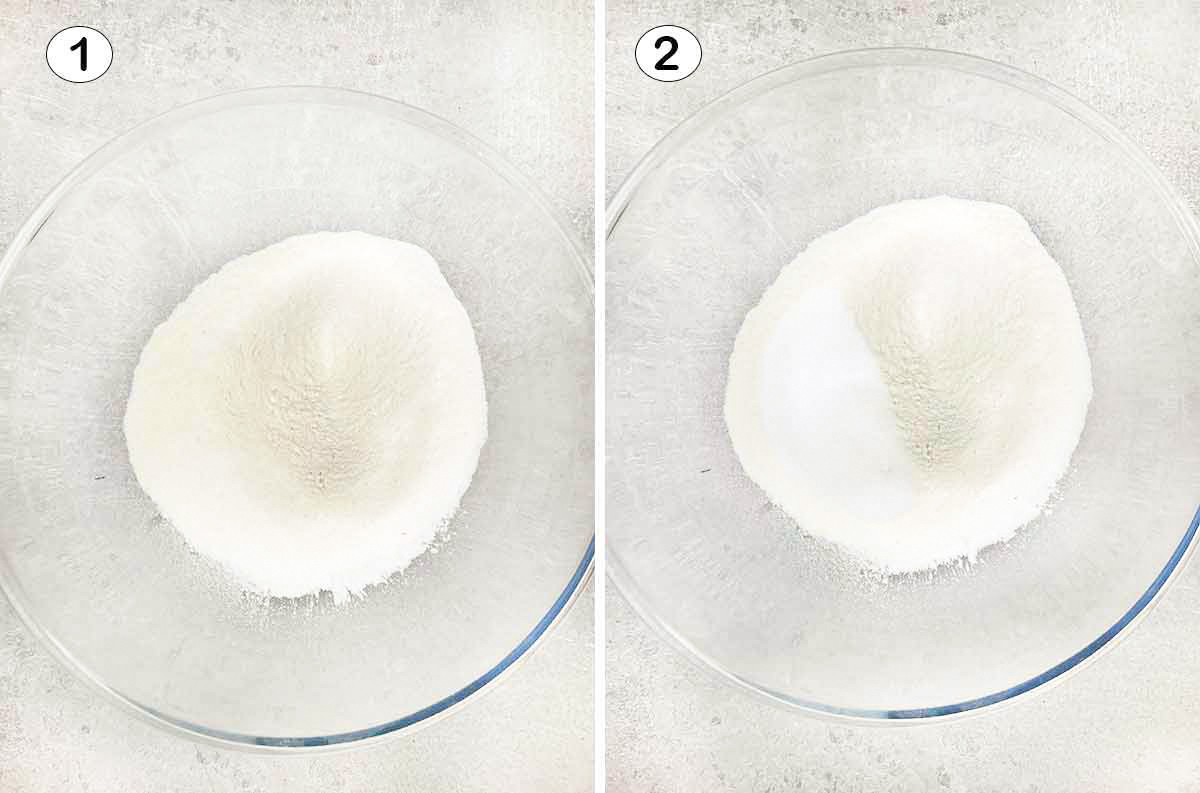
Two: Then take out a large mixing bowl. It should be large enough to fit all the ingredients. In this bowl, sift the flour, baking powder and salt. After which, you’re going to mix in the sugar as well (photo 1 & 2).
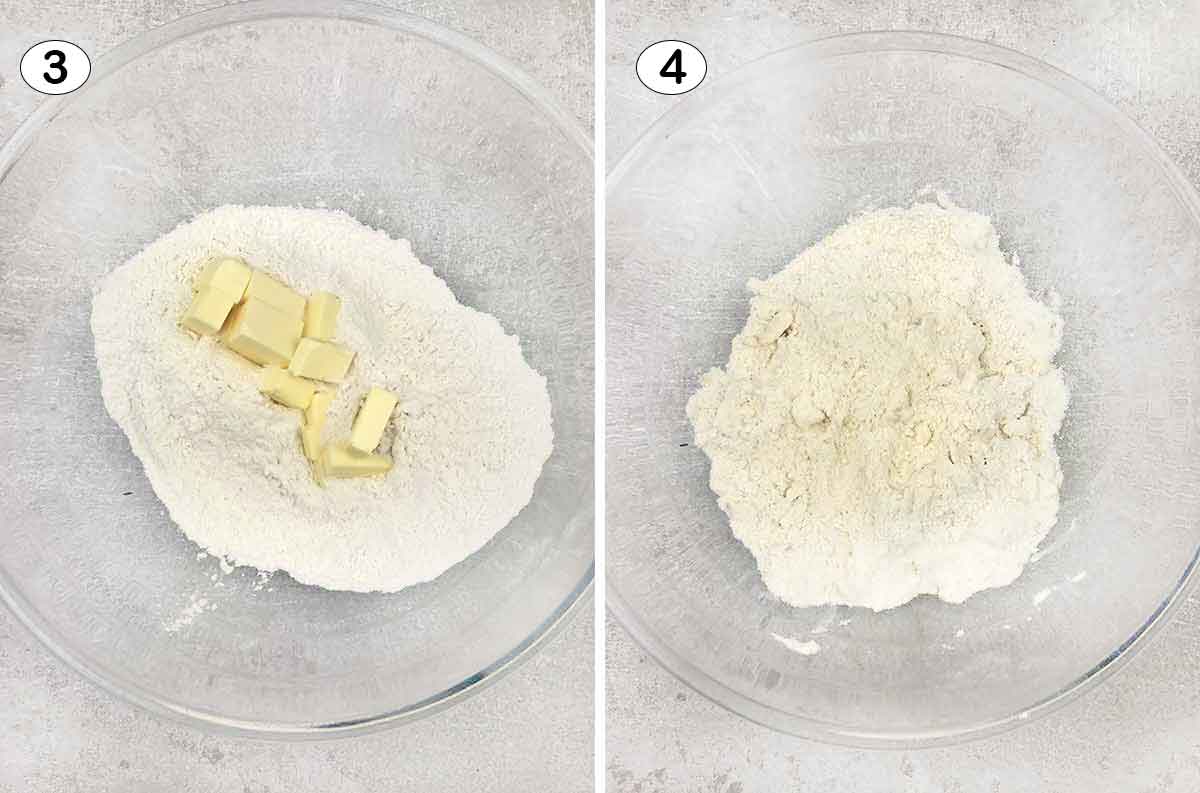
Three: Add in the cold butter. You want to rub it in the flour mixture with the tips of your finger. The consistency of this mixture should look like that of moist sand by now (photo 3 & 4).

Four: Add the milk and the beaten egg. Mix the milk and beaten egg well until it is well combined within the dough. The final dough should be soft, slightly sticky to the touch (photo 5 & 6).
Five: Now, knead the dough by folding the dough upon itself and using your palms and fists to press it all together until it is no longer sticky.
Pro Tip: Remember, scones are meant to be crumbly and flaking. So, the less you knead the dough, the more flaky it will be.
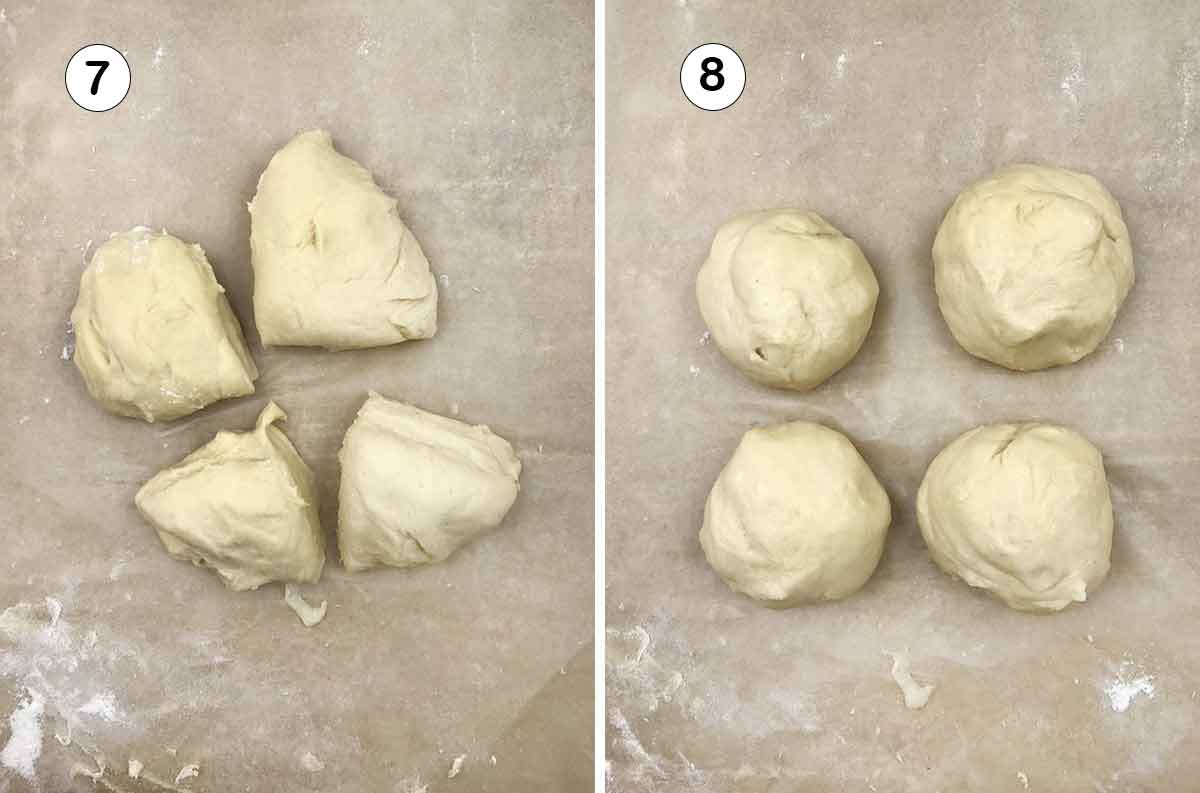
Six: Once the scone dough is no longer sticky, divide it into four equal quarters. Now roll each quarter into a nice round ball and then place them onto the baking sheet (photo 7 & 8).
Seven: Make sure to leave a large space in between them, for they will rise and spread a little while they’re baking. Once placed, using your hands, gently flatten them. Just a little, don’t put too much pressure.
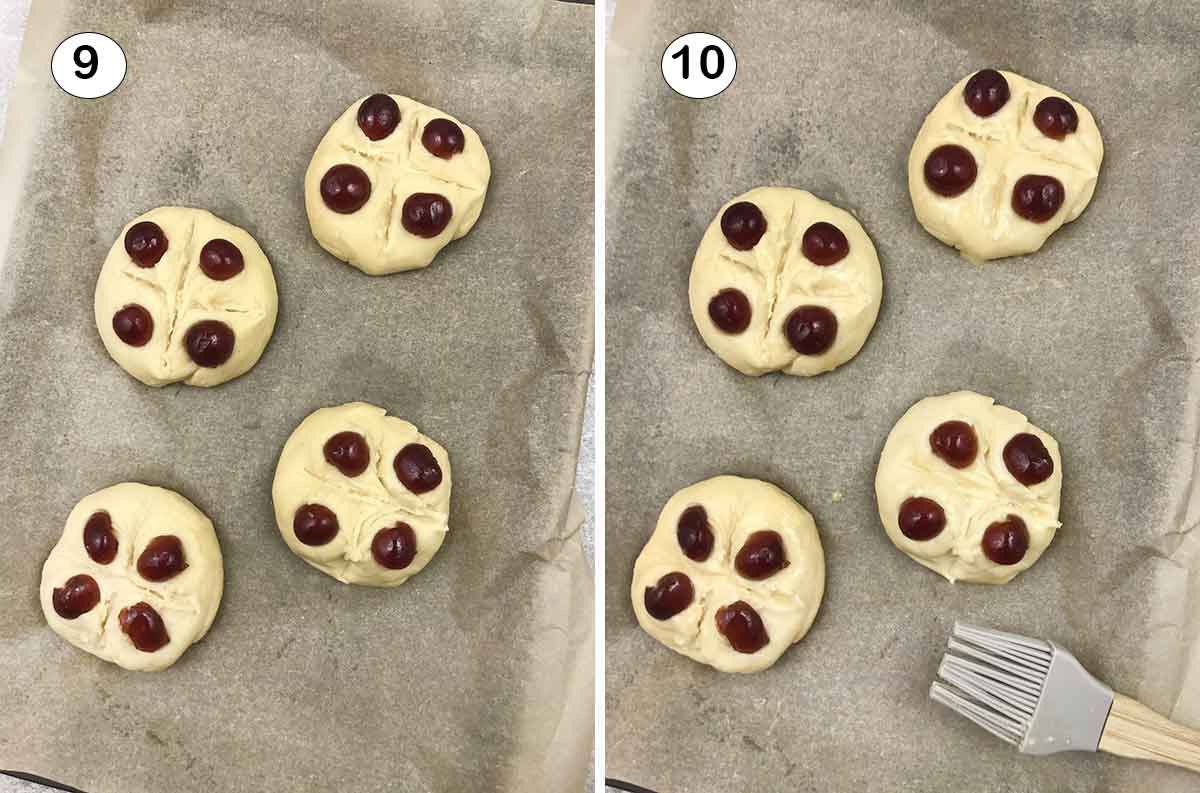
Eight: Now, using a sharp knife, score a neat cross on top of each of the scones. Lastly, brush the tops of the cones with a beaten egg and place half a glace cherry between the lines of the scones that you just scored. 4 half cherries should fit nicely between the cross that you scored.
Nine: Bake until they are nice and golden brown. This should take about 12 to 15 minutes tops. However, you know you’re oven best. That’s it! Once out of the oven, you’re Victorian Scones are ready to be devoured.
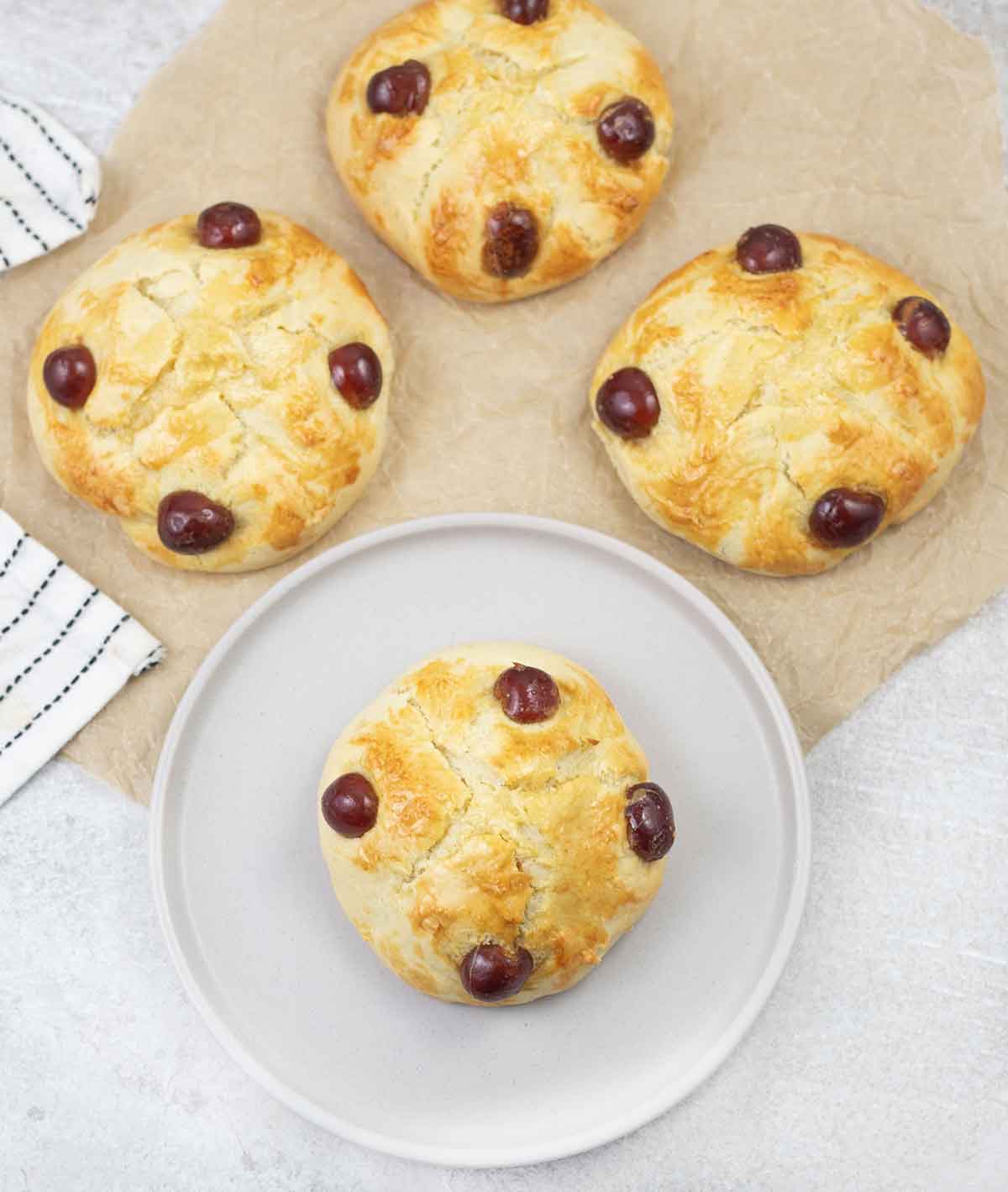
Top Tips
- We often tend to add extra flour on the counter where we’re rolling the dough. Which helps in preventing the dough from sticking to the surface, but it also adds to the weight of the scones. Keep this flour to a minimum if you want light and fluffy scones.
- For best results, it is important that you add very cold butter to the mixing bowl while preparing the dough.
- For well-rising scones that look even from all sides, make sure that you sift the flour with the baking powder and salt well.
Variations & Substitutions
- Instead, or in addition to the glace cherries, add dry fruits of your choice. I recommend walnuts, raisins, cashews or sultanas.
- If you’re a chocolate fan, you can add chocolate chips of your choice to the scone mix before kneading.
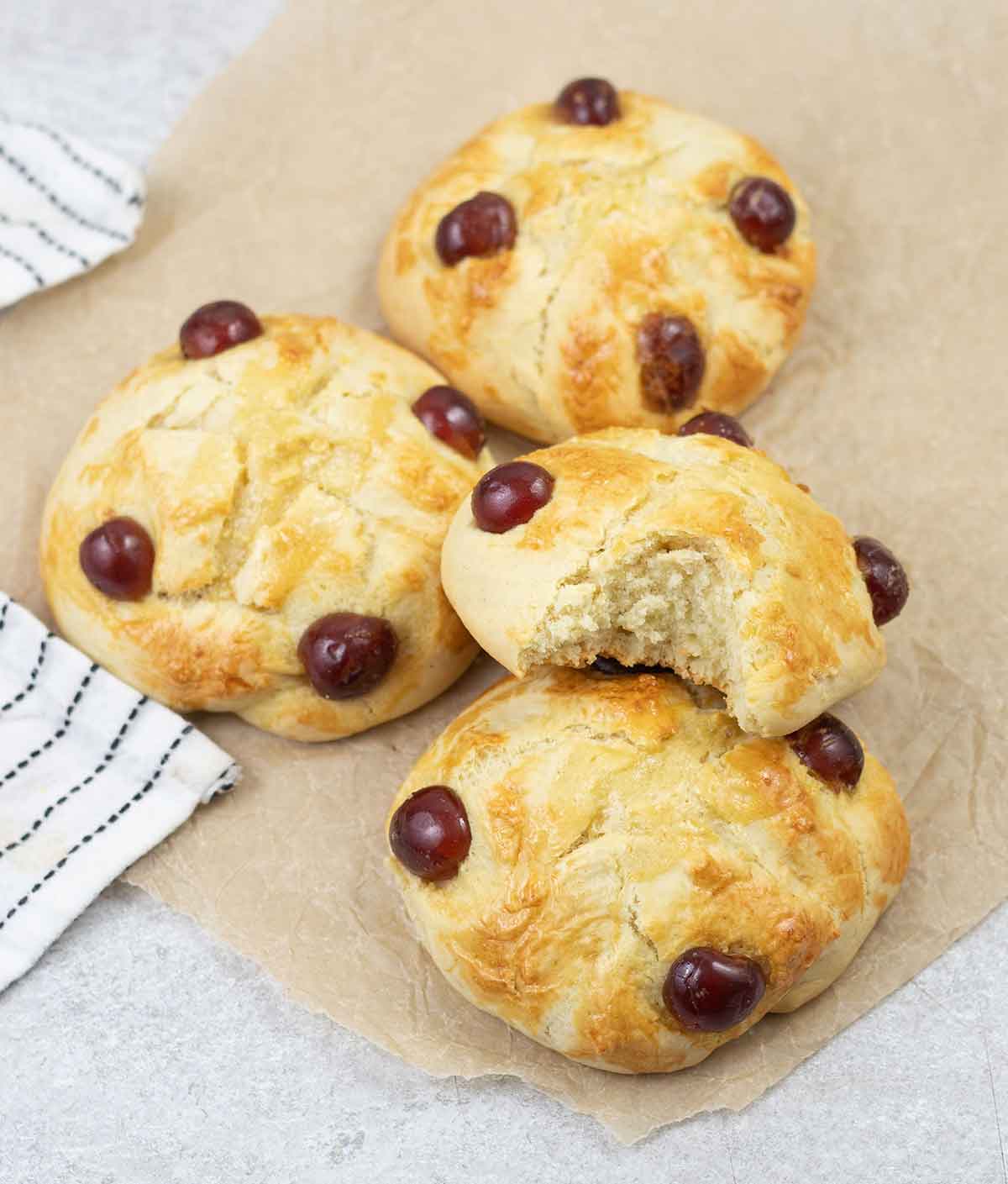
How To Serve
Though scones are traditionally served with a hot cup of tea or coffee, there are plenty of ways to relish them. Here are some I recommend:
Up for dessert? Lather your scones in some fresh cream and jam, and enjoy your fruity-sweet treat.
Fan of fresh fruit? Top your Victoria Scones with blueberries, strawberries or any berries of your choice and a drizzle of maple syrup.
In for a summer treat? Then top your scones with a scoop of your favourite ice cream like Red Bean Ice Cream, Melon Ice Cream or Black Raspberry Ice Cream.
Recipe FAQs
Victoria scones are best consumed the day they are made. This way, you can relish their fresh, flaky goodness. However, if you do have some leftovers, they are best stored in an air-tight container at room temperature for at most 2-3 days.
If you’d like to store it longer than two days, then it’s best to plop the container in the freezer. In the freezer, the scones can last three months. To reheat them, just place them in the oven for 8 to 10 minutes at 160°C/ 320°F.
There is evidence of the word “scone” originating from more than one language. The first one is Dutch, where “schoonbrot” means fine white bread. The second is German, where “sconbrot” means fine, beautiful white bread. Either way, it is rightfully termed, as the texture and light density of the scones is art in itself!
More Scones Recipes
Thank you for checking out my recipe! Follow Healthy Life Trainer on Facebook and Pinterest to keep up-to-date with all new recipes.
Easy Victoria Scones
Ingredients
- 250 g Self raising flour
- Pinch of Salt
- 2 teaspoon Baking Powder
- 50 g Caster Sugar
- 70 g Butter , cold
- 1 large Egg , beaten
- 100 ml Milk
- 8 Glace Cherries , cut into halves
Instructions
- Preheat the oven to 200°C / 392°F and line a large baking sheet with parchment pepper or grease with butter.
- In a large bowl, sift the flour, baking powder and salt, mix in the sugar.250 g Self raising flour, Pinch of Salt, 2 teaspoon Baking Powder, 50 g Caster Sugar
- Add in the cold butter and rub it in the flour mixture with the tips of your fingers until sandy consistency forms.70 g Butter
- Add in the milk and the beaten egg, mix well until combined and a soft, sticky dough forms.1 large Egg, 100 ml Milk
- Gently knead the dough until no longer sticky, then divide it into 4 quarters.
- Roll each quarter into a ball, put them on the baking sheet, leaving a little space between each one, and gently flatten them.
- Let your scones rest for 5-10 minutes and then, with a sharp knife, score a cross onto the top of each scone.
- Brush the tops with beaten egg, then add half a glace cherry into each part of your scored scones.8 Glace Cherries
- Bake in the preheated oven for 14-15 minutes or until golden.
Notes
- Remember, scones are meant to be crumbly and flaking. So, the less you knead the dough, the more flaky it will be.
- For best results, I highly recommend using very cold butter.
- For well-rising scones that look even from all sides, make sure that you sift the flour with the baking powder and salt well.

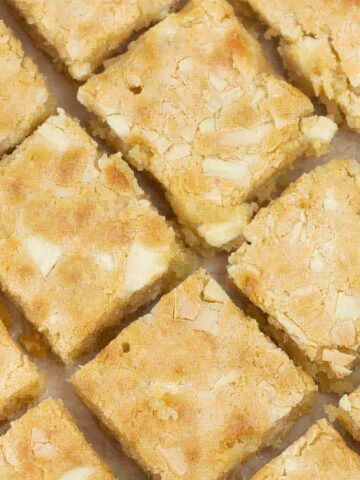
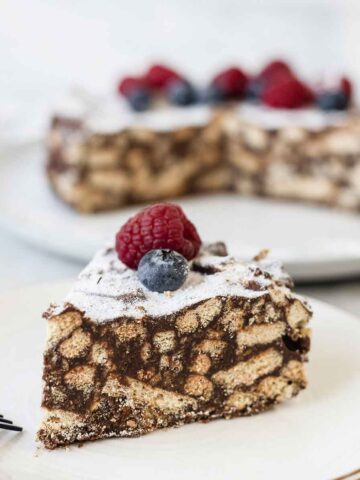
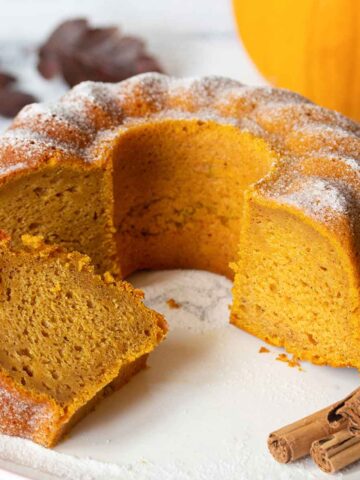
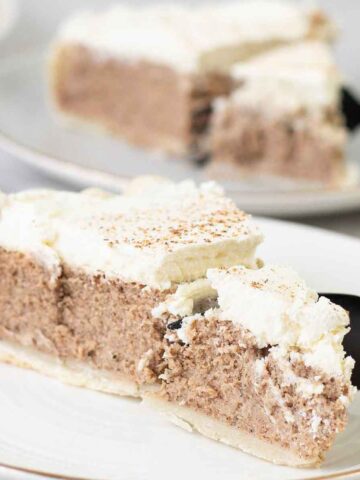

Elizabeth says
This is exactly like my Grandmother's famous recipe, and I love it so much.
Nancy says
I inherited the Bero cookbook from my Great Grandmother and used it often to make many recipes.
Jana says
Me too; I made this bero scone recipe so many times.
Caroline says
I love Bero's recipes!
Monira says
Delicious and easy to make!